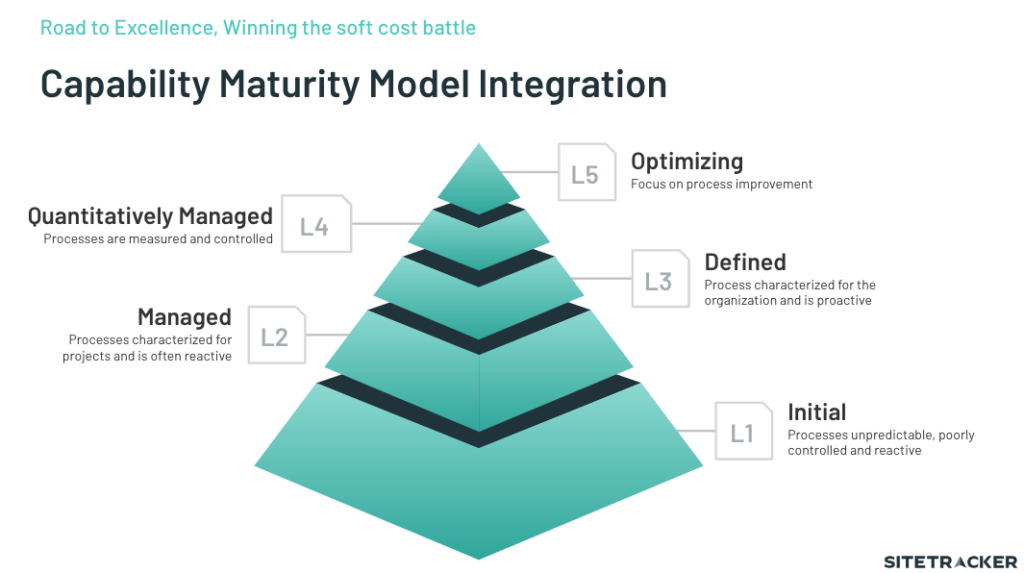In the fast-paced and fiercely competitive solar market winning the soft cost battles is crucial for companies looking to thrive.
Sitetracker recently hosted our first ever Eco-Tech Talk on November 15 to provide valuable insights for winning the soft cost battles and improving execution with software to help solar leaders stay competitive. I sat down with Fadi Abourjeily, Director of Product Management at Sitetracker, and we discussed a roadmap for how software accelerates solar deployments and construction projects. Here’s the recap.
The Building Blocks
We started the conversation by talking about the foundational areas to focus on when creating a roadmap for success. Fadi defined those building blocks as: People, Process, Governance, and Tools.
1. Empowering Your Foundation: The People
At the core of any successful solar project lies the people. The developers, designers, engineers, field crews, project managers, and every individual involved in the day-to-day operations. Empowering them is not just about providing tools but also about fostering a culture of continuous improvement. By elevating the capabilities of the workforce, an organization can set the stage for solar excellence.
“The key building blocks that you have in your hands that you work with every day is first, mainly the cornerstone are your people. These are the people on the ground doing the work, the engineers and developers. Really, they are your foundation. They are the ones that we need to empower to move their execution to the next level, to empower them in every way we can, because they are the heart of the company.”
Fadi Abourjeily, Director of Product Management, Energy at Sitetracker
2. Governance and Continuous Improvement
Building a solid infrastructure and empowering the team is only the beginning. Governance becomes crucial to ensure that processes and tools are continually enhanced. The use of the Capability Maturity Model Integration (CMMI) underscores the importance of measuring progress, setting goals, and continuously improving. This repeatable process, from level one to level five, forms the backbone of long-term success, allowing companies to adapt and optimize their operations continually.
3. Standardized Processes and Accessible Tools
Processes play a pivotal role in efficiency and emphasize the need for standardized, simple, and accessible processes. Many organizations develop effective processes, but they often remain buried in platforms like SharePoint, inaccessible for field operations. The key is to package these processes into tools that guide users seamlessly through their tasks, reducing errors and increasing overall efficiency. We’ll dive a little deeper into tools in the next section.
Key Challenge: Proliferation of Tools
We asked the audience how they would rank their tech stack maturity, and based on the levels provided in the Capability Maturity Model developed by Carnegie Mellon, most attendees identified as Level 1 or Level 2.

What are the different levels and what do they mean?
- Level 1: Initial – Processes are unpredictable, ad-hoc, chaotic, and oftentimes reactive. There’s a lack of standardization resulting in inconsistent outcomes. The key focus here is survival and the most basic project management.
- Level 2: Managed – Basic project management processes are established to track costs, schedules, and functionality. Processes are documented and standardized, although still very much so reactive.
- Level 3: Defined – This mid-point in the maturity model is where processes are well-defined, documented, AND standardized across the organization. There’s a clear focus and goal on proactive process improvement to deliver on project needs.
- Level 4: Quantitatively Managed – This is where it gets interesting; quantitative metrics are used to manage processes. Taking detailed measures of process performance and collecting product quality data to make quantitative process decisions and predictions. Real change happens at this level.
- Level 5: Optimizing – This level is where you need to be in terms of maturity. The organization is now taking quantitative feedback and using it to optimize, create efficiencies and effectiveness. The goal is to focus on continuous process improvement and it’s ingrained in the organization’s culture.
What level does your organization believe it is at? What level is your organization really at?
Here’s what Fadi had to say about the key steps to take in order to level up from Levels 1 to 2 and Levels 2 to 3.
Watch the full replay here.
What’s next?
The path to winning the soft cost battles and staying competitive in a mature market requires a holistic approach. By prioritizing the empowerment of your workforce, implementing standardized processes, utilizing accessible tools, and embracing governance and continuous improvement, your company can navigate the complexities of solar deployment using software.
Remember, solar development & construction is a marathon, not a sprint. It requires ongoing commitment and strategic evolution at every level of your organization.
Want to learn more about Sitetracker? Schedule a demo here.
